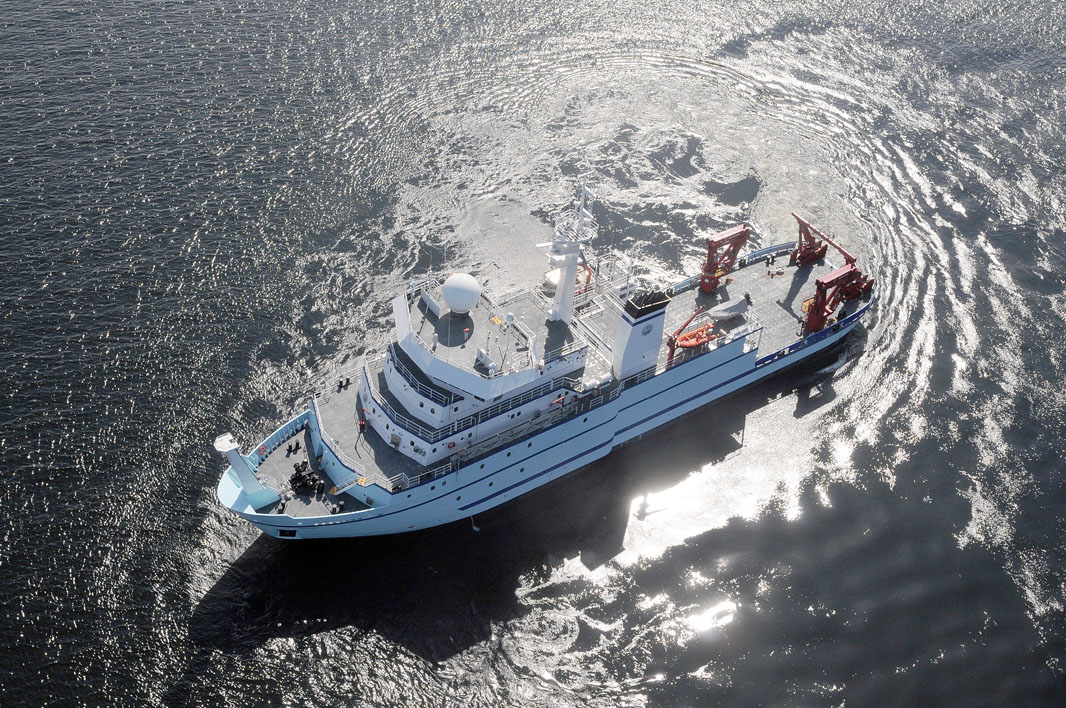ANCHORAGE — Next summer, there’ll be a new ship docking in Dutch Harbor and Nome on its way to the Arctic. But first, the research vessel Sikuliaq is headed to Honolulu for its inaugural research cruises.
This summer, the 261-foot oceanographic research vessel will make its way from the Great Lakes to the Pacific via the St. Lawrence Seaway and the Panama Canal, stopping for testing and research along the way. By February 2015, it is expected to arrive in its homeport of Seward.
The University of Alaska Fairbanks will operate the ship, but it is owned by the National Science Foundation, and scheduling research cruises is done in conjunction with the University National Oceanographic Laboratory System, or UNOLS, said Dan Oliver, the marine superintendent at UAF’s Seward Marine Center.
UAF took delivery of the ship June 6, almost 3 and a half years after fabrication began in January 2011.
The total project cost was $200 million, including $123 million from the 2009 American Recovery and Reinvestment Act (also known as the stimulus bill) for the construction contract.
Scientists will contract the ship at a cost of $44,000 per day, said UAF spokeswoman Sharice Walker. Annually, the operating costs are projected to be about $16 million, Walker said.
The first research cruises will take off from Honolulu this fall.
One is a 50-day look at the ocean floor at the western end of the Hawaiian Island chain in an effort to gauge the impacts of bottom trawling. The ship’s autonomous underwater vehicle and mapping systems will both be used to look at three areas, about 300 to 600 meters deep — one where trawling is underway, one where trawling has never occurred, and one where trawling stopped 30 to 40 years ago.
The goal is to compare the bottom, and see how the former trawling site has recovered, Oliver said.
The second will look at the geologic structure of the Hawaiian Jurassic basin, west of the Hawaiian Islands. That’s about a 30-day trip, and will end in Guam, Oliver said. The research team will use the autonomous underwater vehicle, and conduct a magnetic survey at about 5,000 to 6,000 meters deep.
But first, the Sikuliaq and her crew must finish their preparations. Oliver and the ship’s 20-mariner crew and two marine technicians are readying the boat for its first voyage.
Oliver said the crew is loading the boat with spare parts, outfitting equipment, and getting the computer network installed. The crew also is undergoing training to get ready for operations.
As marine superintendent, Oliver will hop on the Sikuliaq for some transit legs to get to know the crew, but he’s primarily based out of Seward. He’s in Wisconsin now to help prepare the ship.
The Sikuliaq is expected to set sail in early July from the Marinette, Wis., shipyard where it was built. The last task before the ship sets sail will be passing a presail inspection from the U.S. Coast Guard, Oliver said.
Then it’s off to the ocean, where the crew will test the ship’s systems in deep saltwater, including the sonar and over-the-side gear, like winches and cranes.
“We functionally proved that they operate here in the Great Lakes, but we’re not putting out a lot of wire because it’s relatively shallow,” Oliver said.
The ship is outfitted for a variety of oceanographic research, with sonar mapping tools, an autonomous underwater vehicle, and the ability to deploy all sorts of data collection tools, including sediment from the bottom of the sea. “We’ll do a number of cruises out of San Juan into the deep water, Puerto Rican trench, and simulate like we’re doing a fully integrated science cruise,” Oliver said.
The crew will be tasked with deploying multiple instruments at once, and seeing how well the ship fares in different sea conditions. That includes making sure the water system can support lab work and on-deck incubation at once, Oliver said.
Although the Sikuliaq’s first cruises will be out of Hawaii, it was built for Arctic research — specifically, to travel through sea ice.
The Sikuliaq is the first research vessel built to travel unaccompanied in sea ice up to 2.5 feet thick. Oliver said the ship can operate in first-year and marginal ice.
Originally, the Sikuliaq was expected to have its first research cruise in the far north this year. That was delayed, in part because it’s simply a large, and complex, construction project — and in part because record ice on the Great Lakes complicated the schedule, Walker wrote in an email. Oliver said that first four arctic cruises are scheduled for 2015.
One of the cruises will deploy science instruments and moor them to the bottom for a longer-term picture of various data, such as density, temperature, currents and other metrics. Another of the cruises will look at productivity in the arctic, and one will focus on water chemistry. The other arctic cruise will focus on ice, how changes at the ice edge affects the diminishing ice cap and how other ocean changes, like more open water, waves and swell, impact the ice edge.
The schedule is only set as far as the fall of 2015. Oliver said he’ll work with other big-ship operators through UNOLS on the ship’s future plans.
The operators look at all the requests for research cruises from academic institutions, and then fits them onto the various oceanographic research ships available.
“We try to line up the science cruise with the right ship and do it so that we make the most efficient use of the ships,” he said.
Molly Dischner is a reporter for the Alaska Journal of Commerce.


